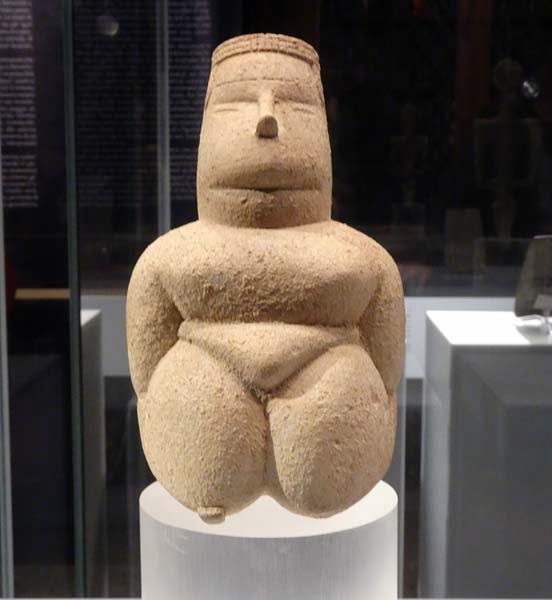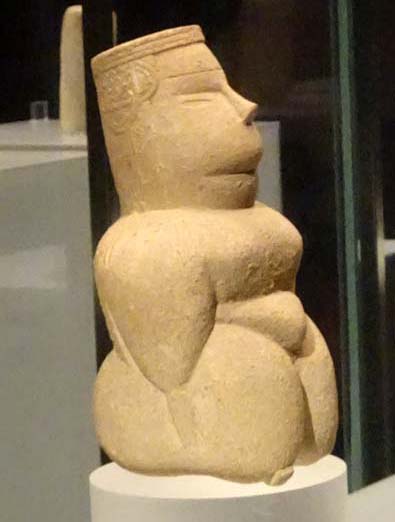Steatopygian female figurine from the XNUMXth millennium BC in standing posture. The legs are fused with the buttocks, the arms are rigidly stretched along the sides, the pelvis is represented in a triangle. The face presents the T facial pattern (line of the eyes orthogonal to the line of the nose). The head, with a flattened top, has a tripartite flat cylindrical headdress, with ear flaps decorated with a motif of broken lines and semicircles in relief. Two fringed bands hang from the ear flaps framing the face, while another band descends from the headdress to the nape of the neck.
The figurine comes from Cuccuru S'Arriu (Cabras), where it was found at the end of the 70s during an excavation in a large hypogeal necropolis from the Middle Neolithic (Bonu Ighinu culture). Inside the 19 tombs that formed the necropolis, female statuettes were found in a volumetric-naturalistic style with a cylindrical head and very accentuated bust and thigh volumes, standing position and open hands at the sides. The Mother Goddess of Cuccuru S'Arriu was found in tomb 386, a circular chamber tomb excavated in the sandstone with a vertical access shaft. The placing of these little idols inside the tombs was part of a precise ritual: the deceased person was placed in a fetal position with the statuette placed in the right hand and the funerary equipment was placed around her body. Inside a bowl inside the burial, two open shells were found which have residues of red ocher, traces of which are also present on the skeleton and grave goods. It is believed that these traces attest to a moment in the ritual in which the body of the deceased person was sprinkled with ochre. The red color recalls blood and its symbolic link with life and regeneration. The presence of female figurines is a complex and debated issue. Among the most widespread hypotheses is the one that sees in these idols the representation of a female deity who holds the secret of the eternal cycle of death and rebirth. This statuette belongs to the cult of the Mother Goddess which was widespread in Sardinia.



Historical notes
The site of Cuccuru is Arrius was explored with scientific intentions for the first time by Tito Zanardelli, between 1898 and 1899; later, more in-depth explorations took place by Atzeni in the 60s and between 900 and 1978 by the Archaeological Superintendency for the provinces of Cagliari and Oristano together with the University of Cagliari. The statuette was found precisely on the occasion of these explorations, inside tomb 1980 which was part of the large underground necropolis dated to the Middle Neolithic (Bonu Ighinu culture).
CARD
LATEST PUBLISHED TEXTS
VISIT THE FACTSHEETS BY OBJECT

